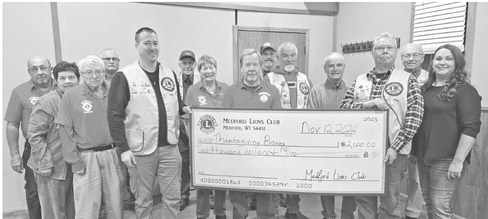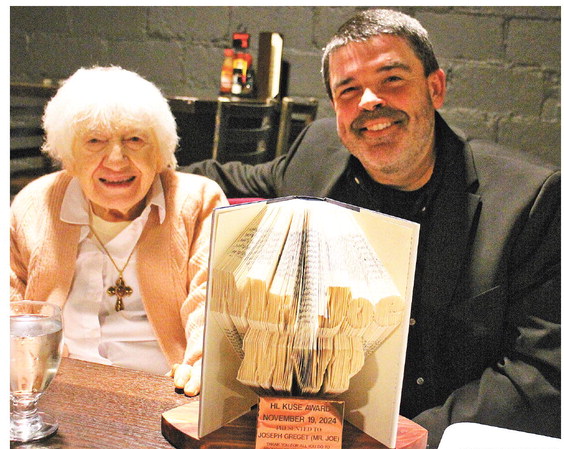Appeals board approves garage placement on lot
Against the recommendation of zoning administrator Bob Christensen, the Medford Zoning Board of Appeals voted on Tuesday to approve a variance request from Mark Temme for a garage on a lot at 1001.5 Shattuck St.
Temme said he purchased the lot with the intent of constructing a garage on it. He said there is currently a dilapidated garage on the property which he is in the process of tearing down. Temme said his goal is to build the garage in a location so that sometime in the future when he doesn’t need the garage, he could sell the lot and the buyer could build a house on the lot. He said by allowing him to place the garage closer to the back (west) property line, it would make the lot a much better building site for a house, which is viable goal for the city. Temme said he would like to place the garage approximately five to 10 feet from the property line so runoff from the roof would flow north and west toward the back of the lot. He said behind the lot is a private road giving access to Bill Brunner’s property to the west so there is not a problem with another house. He said the dilapidated garage is 42 feet from the property line and by moving the new garage further back, it makes the lot a more buildable site in the future.
Chairman Dennis Huotari asked if the city would consider making the private road a street sometime in the future and would require additional land on either side. Christensen said the city has no interest in doing that. Temme added there are better locations for a street than where the private road is.
Huotari said the board looks at several factors in determining whether or not to grant the variance. He said one of them is are there any unique geographical or topographical features on the property. Both Temme and the board agreed there was nothing special or unique about the lot.
Christensen said another factor is would it cause unnecessary hardship if the variance was not granted. Temme said it wouldn’t. He said it would actually cost more to build the garage closer to the back property line than to build it where the current structure is and that he was asking for the variance because it made more sense to move the garage further back.
Huotari said when the board looks at the request, it doesn’t meet the criteria to grant a variance based on what it sees with the property. Temme said he thought he did in the last question about the variance not being contrary to public interest. Huotari agreed that it wasn’t.
Christensen said the board needs to do a quick review of the zoning requirements. He said when a person has a lot, the first structure to go on the lot becomes the primary structure and has to meet all the setback requirements. He said since there is no house on the lot, the garage Temme is planning on building becomes the primary structure and needs to meet all the setback requirements, including the 25-foot rear yard setback. “Had there been a house on that [lot], he could have built three feet from the property line. But without a house, it becomes the primary structure by definition and it has to meet those rules.”
Al Leonard asked if the current structure on the lot Temme is tearing down would not be considered a house. Temme said he asked Christensen if he could get a permit because there was a structure on the lot. He said Christensen asked if he was tearing it down. Temme said he told Christensen he wasn’t going to lie to him and admitted he was tearing the structure down.
Huotari said a garage becomes the accessory structure after a house it built and asked where in the code it said a person couldn’t build the accessory structure first. Christensen replied by definition, the first structure on a property is the primary structure. He said there is no rule in the zoning code prohibiting a person from building a garage as the only stand alone structure on the property. Christensen said a person could build an accessory structure without a primary structure, but they would still have to meet the same setback requirements as a primary structure. He said in the event someone came to the zoning board and said they need to build a garage to store materials and were going to build a house on that lot within the next two years, that would be a different circumstance and board would likely grant the variance. Christensen said Temme’s intention is not to build a house on the lot.
Temme was asked if he moved the garage back just 17 feet to meet the 24-foot setback requirement, could a person still build a house on the lot. Temme said it could be done, but it would be nice to have that extra 20 feet of space. “As I told Bob, if I’m doing this strictly by the book, I could do it and put it right where it is now, but down the road it’s going to make it really challenging to put a home in there. And I don’t want to do that. I would prefer to have it as a place that’s a buildable lot for the future of the city.”
Tim Hansen asked if there was a time limit on building a house. Christensen said there wasn’t. Hansen said to him this made sense, saying he would definitely have reservations if there were houses behind it. Temme said there was a house on the other side of the private road and guessed it was around 75 feet from that person’s property line, probably a total of 100 feet away from were the garage would be.
Hansen said he didn’t see were granting the variance put a burden on anyone since there was already a structure on the lot and Temme was replacing it with another one. He said the lot would look better from the road since Temme would be cleaning up the lot and it was a win-win for everyone by making the lot more sellable in the future for someone to put up a nice house in the city. The other board members agreed it would be an improvement to the lot.
As the discussion developed into whether or not to grant the variance, Christensen said the board should adjourn from the public hearing into the public meeting portion of the agenda to continue the discussion. After convening in the public meeting, Christensen said as the zoning administrator, he could not justify the variance request because it did not meet any of the standards in the zoning code.
“I’ve heard all the arguments both ways and am empathic to the arguments, but from a standards point of view, I have to say that it is my recommendation to not grant this variance.”
Huotari said the problem he has is with the accessory structure versus the primary structure terminology. He said if a person is allowed to construct an accessory structure before constructing a primary structure, based on the terminology, the person should be able to construct the accessory structure where the code said they could put it. “Once you build a home, it automatically reverts to an accessory structure so for me, the terminology in the code is a little bit gray, if you will, and requires you to do something that you’re not required to do after you build you primary residence.”
Lyn Krakenberger said that was a good argument in favor of granting the variance. He said it was a unique situation to build the garage first.
Christensen told the board as a point of order that as part of the final decision, they have to look at each of the requirements and justify what they’re reasoning is in each of those requirements. “What is the unique feature of this property according to this committee? What is the unnecessary hardship according to this committee and is there no harm to the general public? You have to answer each one of those questions as part of your approval process or denial process. . . . If you want to use the argument that it’s unique because it’s a garage and not a primary and it’s really not truly a house because it’s a garage so therefore there shouldn’t be a rule, then say that,” Christensen said, who was the secretary for the meeting and recording it for the record.
Hansen stated his three reasons for the variance. He said it was unique from the standpoint that this was a lot where the garage was an accessory structure, wasn’t near any other buildings and probably wouldn’t be seen by any other buildings because of the woods. He said the hardship for Temme would be in trying to sell the lot in the future for house because the garage wouldn’t be back far enough to provide room for a house in the front part of the lot. Hansen said as far as harm to the public, he thought it was a win-win. He said it increases the property value when a house is built there in the future and it would be a much higher taxable base then the lot is now. “I believe we should grant the variance.”
Following a discussion of Hansen’s comments, the board agreed with them and approved the variance request.


